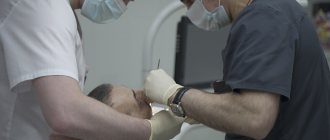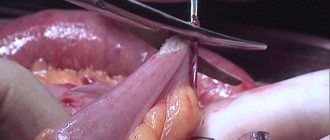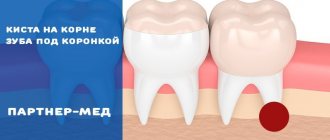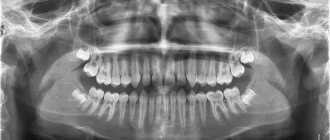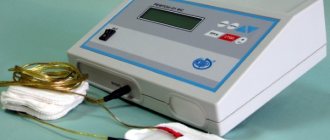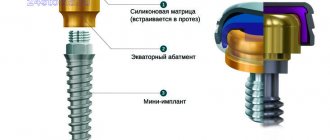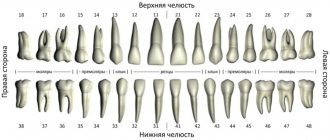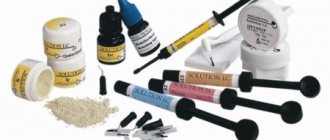- Tooth extraction
- Removal of a tooth cyst
- Bone tissue augmentation
- Resection of the apex of the tooth root
- Installation of a dental implant
- Installation of a mini-implant
Patients have more chronic dental diseases than acute ones. Advanced caries, pulpitis, periodontitis lead to the fact that after a few months or years the patient is faced with a neoplasm on the root of the tooth or its acute inflammation. In this case, resection helps to save the tooth.
When should tooth resection not be performed?
- The main condition for successful root resection is the presence of sufficient jaw bone volume in the patient - at least 5 mm, otherwise there is a risk of jaw fracture.
- A tooth root resection operation will be ineffective if the patient has chronic periodontitis and/or periodontitis, as well as mobility of the diseased tooth.
Tooth root resection is contraindicated if:
- Large cysts or granulomas, when they reach the size of a third of the tooth root or more.
- A completely destroyed dental crown, if the tooth cannot be replaced with prosthetics.
- Close proximity of the roots of healthy teeth.
- Severe mobility of the diseased tooth.
- Some common diseases, such as diabetes, blood diseases, heart diseases, immunodeficiency conditions.
Removing the root of a decayed tooth
Cases where a root remains after tooth extraction are not uncommon. Its removal is a difficult and unpleasant procedure for the patient, even despite the effectiveness of modern anesthesia. Fortunately, the need to remove tooth roots does not always arise. If the root is healthy enough, it is treated and prosthetics are performed. However, removing a rotten tooth root is simply necessary, since its preservation will entail a number of problems:
- Halitosis (bad breath);
- A breeding ground for infection in the oral cavity, possible damage to neighboring teeth;
- The appearance of subgingival stone;
- Spread of infection to the maxillary sinuses, development of osteomyelitis;
- The appearance of cysts and granulomas at its apex ( removing a tooth with a cyst on the root
is a complex procedure); - A decrease in the body’s overall immunity due to the fact that it is forced to constantly fight the source of inflammation.
In order to properly plan the operation, our dentist performs an x-ray examination. The operation itself is performed using local anesthesia, dental forceps or an elevator. Removing the roots of the front teeth
is carried out using rotational movements, and lateral movements using rocking. The most complex cases may require additional manipulations, the use of burs and special microsurgical dental instruments. Removing the roots of the teeth of the lower and upper jaw is a more complex procedure than removing a whole tooth. It requires special training, which consists of examination, diagnosis and sanitation of the oral cavity. The treatment plan is drawn up based on diagnostic studies and the patient’s indications.
Do I need to do a resection or still remove the tooth?
Tooth root resection is a tooth-preserving operation. The dentist will recommend it to you when there is at least the slightest opportunity to save the tooth. If the dentist does not see this possibility, then the conversation will immediately focus on removal.
When will the tooth have to be removed?
- You have a large cyst that affects more than a third of the tooth or several teeth.
- The root of the tooth is destroyed.
- There is severe inflammation of the tissues adjacent to the diseased tooth.
- The tooth is movable.
- Subsequent prosthetic replacement of a diseased, destroyed tooth with a crown is impossible.
How much does tooth root removal cost in Moscow?
The cost of tooth root removal is determined individually, as it depends on how complex the case is. In the dental department of the multidisciplinary clinic CELT, it starts from 800 rubles for a simple removal and ends at 10,000 rubles for a complex removal of a 2nd degree dystopic tooth. You can view our basic prices in this section of our website. In order to find out the exact cost of tooth root removal in our clinic in Moscow, consult our specialist.
In the dentistry of the CELT clinic, you can get a consultation with a dental surgeon, undergo an examination and remove the roots of the teeth, if there are indications for this. We will eliminate any dental problems effectively and absolutely safely.
How is tooth root apex resection performed?
For the patient, resection of the apex of the tooth root is a simple operation and the procedure is tolerated quite easily.
First, the doctor makes an incision in the gum and bone tissue of the jaw to create access to the tumor. After which the tumor itself is removed along with the affected part of the tooth root. The entire cavity is thoroughly cleaned so that not even a small amount of infected tissue remains and is treated with an antiseptic.
Synthetic bone replacement materials are placed into the resulting space, which will take root over time and completely restore the patient’s bone.
Next, the wound is closed with a special self-absorbing membrane and the gum is sutured.
In order to protect the injured area, a bandage may be applied to the gum for up to 1 week.
After surgery, the patient may experience swelling of the gums and pain when chewing, which normally should subside within a few days.
Healing of the mucosa usually occurs in 7-10 days, the bone is restored in approximately 3-4 months.
Preparing for surgery
Before agreeing on the operation, the dentist will prescribe a number of additional tests and examinations. The goal is to ensure that the patient has no absolute contraindications and to pre-develop a strategy for the procedure. You will definitely have to do:
- cardiogram. Resection of the root apex is strictly contraindicated in cases of cardiac arrhythmias, so no sane dental surgeon will undertake the operation without confidence that the patient is able to tolerate it normally;
- blood clotting test. The operation requires a fairly deep and long-term intervention. Of course, any qualified surgeon is able to cope with bleeding in the process, but there is no need to improvise without reason;
- radiography. The photo is needed for three reasons. Firstly, for absolute certainty that the patient has periodontitis and surgical intervention is justified. Secondly, to determine the exact location of the cyst or granuloma and make the incision in the gum and the hole in the bone tissue minimal. Thirdly, to understand how close the maxillary sinuses are to the apex of the root (their damage during the operation is extremely undesirable);
- examinations by specialized specialists (cardiologist, hematologist, otolaryngologist), other tests at the discretion of the attending physician, depending on the individual characteristics of the patient.
If periodontitis is not the only problem, before resection of the apex of the tooth begins, it is necessary to treat all other organs of the oral cavity. In particular, the following may be carried out:
- hygienic cleaning (if there is plaque or stone deposits on the enamel);
- canal filling;
- installing crowns on other teeth;
- any other dental procedures if relevant defects are identified.
What to do after tooth root resection?
Root resection is well tolerated by patients and does not cause major problems even in the postoperative period, but it is necessary to follow a number of rules that will alleviate the condition and speed up recovery.
Typically, after surgery, patients are prescribed antibiotics and vitamin supplements. They must be taken strictly as prescribed by the doctor.
It is necessary to maintain gentle but regular oral hygiene and use antiseptic rinses.
You can't overwork your body. During the healing period, it is better to limit physical and emotional stress.
Do not eat hot or hard food, it should be warm and soft.
Can PRG be considered as an alternative to, for example, gastric banding?
Yes, it is quite. Unlike gastric banding, gastric banding does not leave any foreign material (silicone) in the body. With PG, weight loss begins immediately after surgery, is completed earlier than after banding and does not depend on additional manipulations with the regulated system, but is actually determined by the new anatomy of the stomach. When performing gastric banding, the treatment result does not occur immediately, but only as the system fills, and in the future will depend on how the bandage system functions. Over time, the gastric band, like any equipment, may fail, require troubleshooting, or even replacement. With PRG this is impossible, because no implants are used here. Although, it must be admitted that the gastric banding operation is technically more complex and somewhat more risky than gastric banding. The operation can be performed either openly or laparoscopically. The length of hospital stay is 1-2 days longer than with banding.
Results of longitudinal gastrectomy
Longitudinal resection is effective and is performed in a large number of patients. In the first six months, you actively lose up to 70% of excess body weight and continue to gradually lose weight over 1-2 years until your weight stabilizes.
In case of insufficient weight loss results, the operation is supplemented with gastric bypass. This applies to cases that occur in 12-20% of patients - the stomach stretches and the person begins to gain weight.
A striking example of effectiveness is a 44-year-old man with severe shortness of breath and heart failure, who, with a height of 180 cm, weighed 278 kg. At the first stage after the installation of the intragastric balloon, he lost 20 kg. After resection, the weight stabilized at 120 kg, which allowed the person to live a full life today.
Advantages of ultrasonic root resection PIEZOSURGERY:
- Vessels and nerves are not damaged, since the ultrasound system acts only on the bone and does not injure soft tissues.
- Bone tissue is not rejected, since it is completely synthetic and not cadaveric or animal.
- There is no allergy to the implanted synthetic bone.
- There is no burn or injury to bone tissue, since the bone is not cut out using a cutter or drill.
- There is no unpleasant smell of burnt bone during surgery.
- Ultrasound will completely remove infected, altered tissue from the root apex and will not leave an infection.
- There are no relapses - the cyst is removed forever with a 100% guarantee.
- Laser bone sterilization is the key to complete cleansing of bacteria.
How is the apex resection procedure performed at the Bionic Dentis dental clinic?
This operation may require 30-60 minutes.
The fact is that the duration largely depends on the location of the affected area. For example, when performing treatment in the area of the front teeth, less time is required and the entire process is much easier. When foci of inflammation affect the back teeth, surgical intervention may be delayed due to difficult access.
It is important how many roots are affected by the inflammatory process. If it is one root, the operation will be shorter than three roots.
In any case, local anesthesia is performed before the procedure. We use only the German painkiller Ultracain DS Forte (made in Germany), which allows us to perform the operation without discomfort and pain.
When tooth root resection is planned on unfilled canals, they are first filled. If it is possible to re-treat the canals for at least 2/3 of the root length, they are re-treated.
To fill canals, the Bionic Dentis clinic uses a special technique - 3D canal filling.
Here's what it looks like:
- The canals are expanded and infected tissue is removed from them mechanically using a nickel-titanium M2 instrument. For this purpose, a computerized root canal system from the German company WDV is used.
- After mechanical cleaning, the channels are sterilized with a medicinal preparation, a sodium hypochlorite solution activated by ultrasound. We use the SIEMENS SIROSONIC ultrasound system. Penetrating into the wall of the canal, the disinfectant kills microbes and opens microscopic tubules, clearing them of infection.
- After disinfection, the canal is dried.
- A small amount of epoxy resin, created for use in dentistry, is injected into a dry and clean canal.
- A gutta-percha pin is inserted into the canal and melted under pressure. Melting, gutta-percha fills all the pores in the canal and micro-branches.
- Next, the channel is filled with molten gutta-percha under pressure from an injector.
The use of this technique is standard in Europe. We also follow this method.
Difficulties of conservative treatment of cysts and granulomas when using outdated treatment methods.
As a result of poor-quality filling of dental canals, inflammation in the bone tissue can develop. When depulpation is performed, for example, during the period of treatment of pulpitis, the pulp is removed and the canal is filled to the full depth of the tooth root. There are cases when this procedure was not performed completely, and the empty area became a favorable place for the development of the inflammatory process with the subsequent formation of a cyst. The technique used in Russia in 99% of public dental clinics and 80% of private dentistry is outdated and does not give a positive result of endodontic treatment. The drugs used are obsolete, and the technique does not disinfect the canals 100%.
As a result of such treatment, the dentist does not completely remove the infection from the canal.
The method of laser treatment of dental pulpitis according to the European protocol is recognized throughout the world. You can find it on our website on the LASER TREATMENT OF PULPITIS page. Only such treatment guarantees the absence of complications and excludes the development of granulomas and cysts after canal treatment.
Another situation is when poor-quality filling of tooth canals is associated with the use of the Soviet resorcinol-formalin method of dental treatment. With this technique, popular in the USSR, the tooth canal was not treated, but a mixture of resorcinol and formaldehyde was poured into the tooth, which was supposed to kill and preserve the nerve. However, dentists could not tell by eye whether complete preservation of the nerve had occurred. And most often, the nerve began to rot in the canal a year and a half after using this technique. To treat such a tooth, the dentist must remove the old root filling and perform the canal filling procedure in a new way, using modern technology. However, repeated filling of such areas, especially when the canals are too tortuous, often leads to perforation of the root wall. This is an unpleasant complication that is difficult and expensive to correct. For this reason, based on the data after the CT scan, a decision is made on what will be the best treatment option. Sometimes doctors believe that it is better not to take risks, not to try to clear the resorcinol-formalin channels, but to perform an excision of the apex of the tooth root in order to remove the cystic formation and inflammation.
It is also possible that situations where the canal directly in the part of the apex of the tooth root is not completely sealed, and there is a crown, inlay or pin on the tooth. As you know, conservative therapy involves replacing the old crown, subsequent filling and installation of a new version of the crown. While removing a pin made of high-strength material often causes a root fracture.
In our clinic, we successfully extract stump inlays and pins of any type from the roots of the tooth using an ultrasonic unit SIROSONIC SIEMENS (Germany), however, this is rare equipment and is available in no more than 1% of dental clinics. Therefore, mid-level clinics convince the patient that he is indicated for resection of the apex of the tooth root, since it is the easiest and safest method of eliminating infected tissue.
The same treatment tactics are offered to patients if a foreign body is detected near the tooth roots, and this procedure will also be prescribed. During dental procedures, cases sometimes occur when fragments of the instruments used for this remain in the canals. The consequence of such negligence is usually the development of inflammation, which requires urgent and effective therapy.
Working according to European protocols for endodontic treatment, dentists at the Bionic Dentis clinic in 97% of cases, when a dental cyst or granuloma is detected, carry out therapeutic non-surgical treatment of the dental cyst with a laser.
However, there are those 3% of teeth that cannot be treated with laser. There is also a category of patients who refuse laser tooth treatment through a root canal, for the reason that a crown or bridge is installed on the tooth, and the patients want to keep this crown for financial reasons.
We offer laser resection of the tooth root to such patients.

